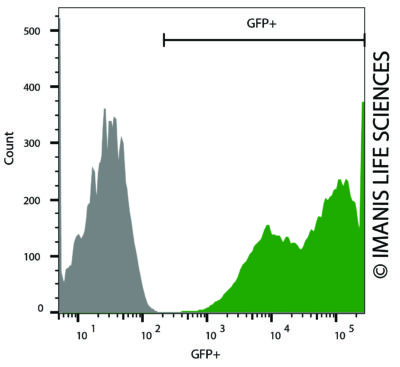HCT116-eGFP-Puro
| Species | Human |
| Cell Type | Colorectal Carcinoma |
| Transgene | Enhanced green fluorescent protein (eGFP) |
| Selection Gene | Puromycin resistance (Puro) |
-
Description
HCT116-eGFP-Puro is a polyclonal population of the human colorectal carcinoma cell line HCT116 (ATCC® CCL-247™). To achieve stable reporter expression in the polyclonal population, parental HCT116 cells were transduced with LV-eGFP-PGK-Puro (LV031) and selected using puromycin. LV-eGFP-PGK-Puro encodes the enhanced green fluorescent protein (eGFP) cDNA under the spleen focus-forming virus (SFFV) promoter and the puromycin resistance gene (Puro) under the mouse phosphoglycerate kinase (PGK) promoter.
*The ATCC trademark and trade name and any and all ATCC catalog numbers are trademarks of the American Type Culture Collection.
This cell line has been tested for mycoplasma contamination and is certified mycoplasma free.
The parental HCT116 cell line has been authenticated and certified free of interspecies cross contamination by short tandem repeat (STR) profiling with 9 STR loci.
Replication Competent Lentivirus (RCL) Test (including a test report) is available for this cell line at an added cost. Contact us to learn more.
-
Characterization
Morphology
 Low and high density cell morphology (200x).
Low and high density cell morphology (200x).GFP Expression
 Flow cytometry of HCT116-eGFP-Puro for GFP expression (green) versus control (gray) cells.
Flow cytometry of HCT116-eGFP-Puro for GFP expression (green) versus control (gray) cells. -
Growth Conditions
Complete Growth Medium: DMEM supplemented with 10% FBS, 1X Penicillin/Streptomycin, and 1 µg/mL puromycin.
The addition of puromycin to the complete growth medium maintains high reporter expression over continued passage of the cells. It is highly recommended, especially if the cells undergo multiple passages prior to being used for studies.
These cells should be grown in the indicated medium and passaged when they reach confluency. For routine passaging, cells are recommended to be split at a 1:10 ratio every 3-4 days.
HCT116 cells can detach from tissue culture surfaces upon repeated washing. Coating culture plates with poly-D-Lysine prior to use is recommended for applications involving frequent washes or culture media changes.
-
Usage Information
These cells are suitable for in vitro and in vivo experimentation. HCT116 cells are a xenograph model for colorectal carcinoma and will form primary tumors and distant metastases (lung, liver, and lymph nodes) post-implantation into immunosupressed mice.1,2 eGFP is not recommended for whole animal in-live imaging. Rather, samples can be collected postmortem for analysis by conventional fluorescence microscopy or flow cytometry.
The cells can be amplified in vitro and used to generate additional frozen stocks. Cryopreservation of low passage stocks is recommended. Frozen stocks should be preserved in a designated cryopreservation medium.
These cells were generated via lentiviral vector transduction. The lentiviral vector used for transduction was a self-inactivating (SIN) vector in which the viral enhancer and promoter have been deleted. Transcription inactivation of the LTR in the SIN provirus increases biosafety by preventing mobilization by replication competent viruses and enables regulated expression of the genes from the internal promoters without cis-acting effects of the LTR3. Nevertheless, all work with these cells should be performed under biosafety-level 2 (BSL2) conditions by trained personnel. Institutional requirements may permit handling of these cells under BSL1 conditions if certain criteria are met.
References:
1Brattain et al. Cancer Res. 1981. 41:1751-1756.
2Yang et al. Anticancer Res. 1997. 17:3463-3468.
3Miyoshi et al. J Virol 1998. 72:8150-8157. - Datasheet/COA